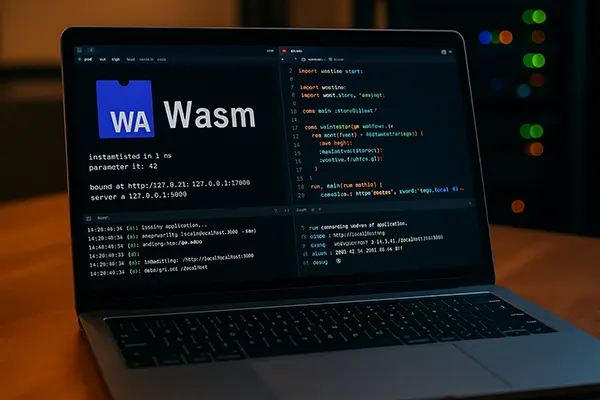
Wasmtime, Spin and WebAssembly Beyond the Browser: A New Era of Lightning-Fast Server-Side Microservices
WebAssembly (WASM) is no longer confined to front-end experimentation. In recent years, it has transformed into a serious contender for running secure, fast and lightweight microservices outside the browser. This article explores how Wasmtime, Spin, and the general evolution of WASM are creating a server-side revolution that may eventually rival Docker and redefine the landscape of edge and serverless computing.
WebAssembly: From Browser Plugin to Backend Powerhouse
Originally conceived as a performance-oriented alternative to JavaScript within browsers, WASM has now firmly broken free from that environment. It is increasingly used in back-end systems where security, speed, and portability are critical. WASM modules run in a sandboxed environment, consuming minimal resources while ensuring near-native performance across different operating systems and hardware.
The core promise of WASM on the backend is simple: minimal cold start times and ultra-light runtimes, all without traditional container overhead. This makes it particularly attractive for cloud-native applications that need to scale rapidly and execute workloads on-demand. The cross-platform nature of WASM binaries also reduces infrastructure complexity, enabling developers to “write once, run anywhere” in a true sense.
In 2024, both commercial and open-source ecosystems began embracing WASM as a viable Docker alternative, particularly in edge computing scenarios. Projects like Fermyon’s Spin and the Bytecode Alliance’s Wasmtime are leading this movement by creating developer-friendly tools and runtime environments optimised for backend use cases.
Security and Portability in Modern Architectures
One of the standout benefits of WASM in server-side environments is its robust security model. Each module runs in an isolated, deterministic sandbox that prevents unauthorised system access by default. This helps eliminate entire classes of vulnerabilities often found in traditional containerised workloads.
Portability is another strong selling point. WASM modules are compiled to a binary format that can run consistently across x86, ARM, and RISC-V processors. Combined with emerging support for WASI (WebAssembly System Interface), developers now have access to essential system calls without compromising WASM’s tight security posture.
Major cloud providers like Cloudflare and Fastly are already using WASM to deploy user-defined logic at the edge. This trend is expected to accelerate throughout 2025, as developers and platform engineers seek lighter, safer alternatives to virtual machines and containers in latency-sensitive environments.
Wasmtime and the Rise of Server-Side WASM Runtimes
Wasmtime, maintained by the Bytecode Alliance, is one of the most mature WASM runtimes available today. Built with safety and performance in mind, Wasmtime enables the execution of WASM modules in a standalone context, without the need for browser support or bulky container engines.
The 2024 release cycle saw Wasmtime gain significant performance improvements and increased support for WASI. Features like reference types, component model support, and integration with Rust, Go, and .NET make it extremely flexible. It’s now used in production by enterprises aiming to deploy safe microservices with extremely low memory footprints.
Wasmtime also supports ahead-of-time (AOT) compilation, which enables faster startup times and reduced runtime overhead—ideal for serverless and real-time applications. As of early 2025, Wasmtime powers various open-source frameworks and is integrated into experimental Kubernetes environments for fine-grained control over ephemeral workloads.
Why Wasmtime Matters for DevOps
From a DevOps perspective, Wasmtime simplifies software supply chains. Since WASM binaries are deterministic and compact, they are easier to audit, test, and distribute. This significantly reduces the surface area for CI/CD vulnerabilities and improves software provenance tracking.
Wasmtime’s low runtime overhead also means that it can be embedded into other applications or APIs directly. This enables dynamic code execution in trusted environments—ideal for custom plugins, policy engines, and function-as-a-service platforms.
Combined with its growing ecosystem and native integration in multiple languages, Wasmtime enables engineering teams to build efficient systems that are both maintainable and secure. It represents a major step towards decoupling infrastructure from traditional operating system dependencies.

Spin Framework and the WASM Developer Experience
Spin, developed by Fermyon, is an open-source framework that aims to make building and deploying WASM microservices as easy as writing a web page. It provides a full developer experience tailored for WASM, including local development, testing, packaging, and deployment via Fermyon Cloud or any WASM-compatible host.
One of Spin’s standout features is its use of trigger-based configuration. Developers can write lightweight WASM components in languages like Rust, Go, or TinyGo and trigger them using HTTP, Redis queues, or scheduled tasks. This model enables building microservices with virtually zero cold start delay, even on modest hardware.
As of February 2025, Spin is increasingly used for edge computing, multi-tenancy applications, and internal tooling due to its minimal latency and seamless deployment process. Its developer-first approach is helping bridge the gap between traditional server-side developers and the emerging WASM landscape.
Developer Productivity with Spin
Spin’s CLI simplifies the build and deploy process through intuitive commands that generate scaffolding, manage dependencies, and package WASM binaries. With built-in templating and hot-reload features, it dramatically reduces the development cycle for microservices and APIs.
Another important aspect is its extensibility. Plugins and integrations are actively being developed, allowing Spin to connect to external services, secrets management, and observability stacks. These features are crucial for enterprise adoption.
Fermyon Cloud, the managed hosting platform for Spin applications, enables zero-config deployment of WASM services globally. It offers real-time telemetry, performance dashboards, and instant rollbacks—elements that make WASM truly production-ready for the enterprise tier.





